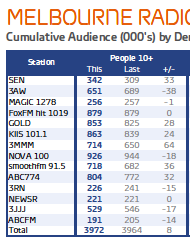All the talk of cume verses share after the last ratings got us thinking about cumulative audience.
On ratings day the cume figures are not released at the same time as the share figures, but they are uploaded onto the GfK website some time afterwards, along with the share figures (see below) and the average figures.
It is these cume (cumulative audeince) figures that are being quoted by Nova’s Paul Jackson when he talks about how many people are listening to his stations. Cume is sometimes referred to as weekly listening, total listening, reach, or other more ‘friendly’ terms than the often confusing term ‘cume.’
When talking to radioinfo after the third ratings results, Jackson expressed it like this: “NOVA 100 (in Melbourne) is the second most listened to station in Australia… If you ask the question, in our market here in Australia, ‘How many people watch a TV show of a night?’ we deal in cume… NOVA 96.9 is the most listened to station in Australia 974,000 cumes. And NOVA 100 is the second most listened to station in Australia with 944,000 cumes.”
The cume reports look like this (click to see full report).
Share of audience is the percentage of total radio listening audience during a given time period tuning to a particular station. Share is a station’s average audience expressed as a percentage of the totalradio audience for the same period, according to the information in GfK’s ratings tool kit.
In decades past, Commercial Radio Australia (then FARB) tightly governed the way ratings results were expressed, but CRA has softened its view on how ratings are discussed in recent years, allowing the more flexible current approach. While this is good for stations, it can sometimes confuse advertising buyers, who like to compare apples with apples.
CRA chief executive Joan Warner has told radioinfo: “Commercial Radio Australia has no position on the relative value of cume or share measurements. Each station has a different view and what their advertisers want. It provides advertisers with two ways to buy – frequency with a particular audience or do they just want to get the message to as many people as possible.”
Stations have always used share, cume, average audience and more detailed shift breakdown figures when selling to clients, but share has always been the ‘common currency’ when discussing the big picture of ratings results on survey day. We asked Warner, has something changed? “Share is still the common currency,” she replied. “GfK will continue to provide the Share Summary to media on survey day for reporting. Cume is included in the a 3 page summary which is up on the GfK website each survey. GfK provides a Tool Kit for subscribers outlining further details of terms and use.”
Survey results are now being collected by online as well as paper diary methods, and the new methodology has been readily accepted by agencies, who had been seeking a more ‘modern’ way of collecting data before the new ratings contract was awarded. As long as stations clearly explain what they mean when they quote their data, media buyers are likely to accept the different ways of expressing ratings success, but if they perceive confusion of dissent within the industry, they may begin to question the messages they are hearing. The industry will need to monitor this debate.




